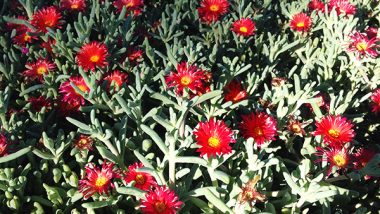Last updated on October 26th, 2025 at 10:03 am
Salvia Plant Care. Most folks call these plants Saliva’s but also referred to as Sage. These plants are beautiful medium care types of plants that are drought tolerant after they become well established. Herbaceous Salvias like Mexican and Chapparal sage will come back after the winter seasons.
Annuals or Perennials?
Other types of salvia are basically planted as annuals. They are typically shorter and used in containers or in garden beds. However, they should always be planted in full sun making sure your soil drains well especially if they are in a container.
These plants are somewhat drought tolerant but best to leave them on a drip system during the hot mid-summer months.
When is the best time to plant them? During the mid-spring season.
Salvias are hardy plants
All Salvias are moderate to fast-growing and once established are low-water plants. It is always best to use a good organic type of soil. They can be used in containers as the blooms will last from late spring until mid or late summer.
Types of Salvias
There are literally thousands of varieties and salvias and they are in the mint family (Mentheae). I’ll write about the most common ones including the ones that do well in most gardens including the Southwest Garden.
Common short but beautiful salvias for your garden
- Furman’s Red
- Blue Salvia
- Victoria Blue
- Pink Salvia
- Hot Lips Salvia
You can read more about Salvias on Wikipedia.
Red Salvia (Salvia Splendens)
Red saliva is a good plant for the desert southwest landscape. It is best to plant them in mass or numerous ones in one place. You can also use them as a small hedge or line them up for a good showy mass of red color. Depending on the type of red salvia they will grow anywhere from 3 to 6 inches tall and about 1 ft. wide. The most common red sage is the Furman’s red sage ask for it at your nursery store.

Victoria Blue Salvia
This bright blue salvia will make your garden pop with color. Like all salvia it will bloom from mid-summer until early fall. It is also called the Mealy cup sage and will spike up to 8-10 inches tall. In your garden, it is best to plant it in the background and place smaller perennials/annuals in front.
Mexican Sage or Salvia (Salvia Leucantha)
The Mexican sage plant is very hot and cold hardy. Also called the Mexican bush sage. It can tolerate temperatures down to about 20 degrees f°. Anything lower than that and it may not come back the following spring. It produces a spikey, beautiful, dark purple flower. Please do not confuse it with the Chaparral sage. More about this plant is below this paragraph. The USDA zone for this plant is 8-10. Cut it down to the ground after the first hard freeze. It will grow about 4-5 ft. tall and 3-4 ft. wide.

Red Hot Lips Salvia
A brilliant red and white flower that will bloom from about late spring until mid-fall. The plant will grow up to 3 ft. tall and wide. Easy care and lower water plant. They do great in the full sun. Butterflies and hummingbirds love this plant. Cut down after hard freezes, as it will bounce back year after year.
Chaparral Sage (Salvia clevelandii)
Remarkably similar to Mexican sage and many landscapers and gardeners will confuse these two plants. The flower is more of a bluish color, and the height and width are the same. The chaparral stems shoot out straight, and the bloom will start at the bottom and continue upwards. The USDA zone for this plant is 8-10. Cut after the first hard freeze. Water about every other day after initial planting during the first summer seasons, once per week after it becomes established.

Salvia Plant Care
Problems with sage/salvia
These plants are very hardy and are usually disease and insect-free; however, on occasion, spider mites and powdery mildew will attack these plants. Use neem oil as an organic spray to remove spider mites, and it will also help with powdery mildew. Remember, it’s important to plant them in full sun and good organic soil that drains well. Learn more about insects and diseases on plants.
Salvia Plant Care
Looking for Russian Sage? Learn How to Grow Russian Sage.
If you are looking for Texas Sages (lecuphyllums) check out this post, Texas sage bushes.

Greenhouse Manager, Master Gardener, and Webmaster.
If you have any questions or enjoyed this post, feel free to share your thoughts in the comments below.




